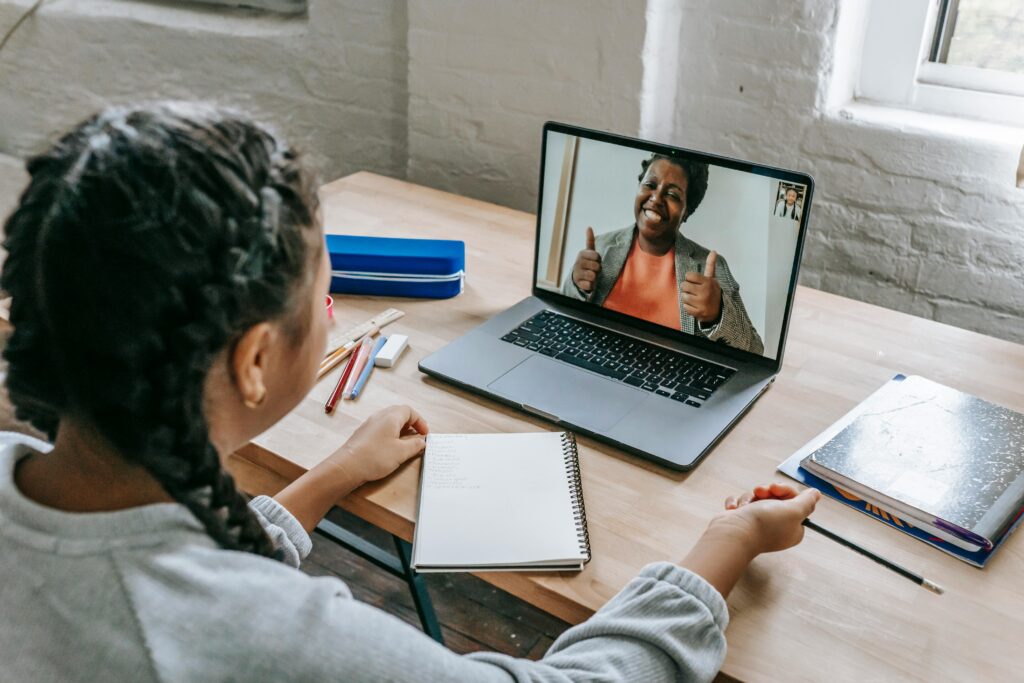“Hey Daniel, are you winning?”
No response.
“Daniel, can you hear me?”
His camera is on. He is very focused. His eyes and mouth are moving ever so slightly.
Now, this is not a technique I would recommend a teacher use, except under very specific circumstances. In this case, I was pretty sure I knew what was happening, and I knew this student quite well from teaching him previously. He could handle this type of attention.
The class was silent now. Twenty-two puzzled faces watching both Daniel and me attentively.
“ Daaannniel …, “ I repeated slowly, with that tone I use to wake my sleeping teenagers on a lazy Saturday morning.
Daniel started to show signs that I was getting through.
“I said, ‘Are you winning?’”
“Huh. Oh. What? Sorry!”
“I was just wondering if you were winning your video game?” I responded with a tone of kindness, curiosity, and a hint of cheek.
My students know that I don’t get mad at them and that I love a good laugh. So Daniel responded as I hoped he would. He laughed, admitted that I caught him, turned a slight shade of red, and apologized. The class loved this interaction (I think).
“How did you know?” Daniel asked.
“It’s super easy for us teachers to know when a student is doing something else on their screen.” Slight hyperbole, perhaps.
Moments like this one help to set and maintain expectations in a virtual synchronous class.
Some readers may feel that my interaction with Daniel (names have been changed to protect the “innocent”) was unprofessional of me and embarrassing for the student. In many situations I would agree. But in this case, I continued to have a great student-teacher relationship with Daniel. He signed up for more of my courses the following year, and I received a very kind email from his mother about how much he enjoyed my classes.
While there are many techniques a teacher can use to help keep students engaged in an online synchronous class, building and maintaining a strong student-teacher relationship is the most important one. The other techniques all work much better when students sense that you see them and care about their success.
The following are four strategies I use in my online courses as I endeavour to create and maintain an engaging and supportive environment in my online synchronous classes.
Build relationships

As AI spreads its digital tentacles further and further into the education ecosystem, the value of real relationships will increase. The student-teacher relationship has always been of utmost importance. That is not going to change, but it will become even more valuable in the coming years. So, make sure you prioritize time to get to know your students and to help them get to know you. I try to start my classes with three to five minutes of casual interaction. I might share a story about something that happened to me in the past few days or ask if anyone has had a birthday since we last met. “What did you do for your birthday?” or, “What did you get?” are great questions that will get even the quietest student to talk. The verbose students will soon jump in on a casual conversation. Be interested in their answers and ask follow up questions. Don’t be in a rush to start teaching. By taking time to visit, you acknowledge each student’s value as a whole person and encourage the rest of the class to do likewise. Even the most distracted of students will listen when a classmate shares an interesting story about their week or recent birthday. Getting quiet students to talk is a big win, in my books!
Watch and respond
I require students to have their camera on during my classes unless they are sick, anxious, or are joining from a distracting environment. This is a crucial ingredient in the recipe of an engaging class. If you don’t require this, make that change as soon as possible. Not only is this engaging for the students, it’s more fun for the teacher. I enjoy watching the faces of my students when I try to crack a joke, I say something intellectually provocative, or simply mess up my words and say something incorrwrongly. When an entire class can see others react and engage with the topic, it’s contagious. I like to encourage this by verbally acknowledging the facial expressions I see. Rayleen and Elvira were two students who really enjoyed this. They were close friends who lived in the same community and took several of my online classes together over the course of a few years. I would catch them making eye-contact through Zoom! Did you know that that is possible? It is! One would smirk and her eye brows would raise and the other would see that and crack up, and I knew they were having an inside joke about something I had just said. Rather than just try to move on or keep focused on my teaching, I would often seize the moment and make the most of it.
“I saw that, Rayleen and Elvira! What’s so funny!?”
They would crack up, surprised that I had noticed their silent interaction.
“I saw that eye-contact. You both smirked! What did I say?”
At the risk of stating the obvious, it’s my belief that when students know that you’re actively watching their faces, they feel seen.
Here are some other things I said to students in online classes this past year:
- “Michael, are you laughing at me?”
- “I can see that Erin likes that idea! Look at that smile!”
- “Josh is thinking hard! I can see his brain smoking!”
- “Do you not agree with that statement, Lisa?”
These are the types of statements that I feel comfortable saying, as they fit with my own personality; your personality will be different, and whatever you choose to say, you need to make sure that it is authentic for yourself and your teaching style. The key point, though, is that when our students feel seen and known — when you show your students that you are fully engaged in teaching them as individuals — they will learn better. They want to know that you’re not just a talking head on a screen giving a lecture.
Acknowledge their successes in front of the class

Most students enjoy being in the spotlight, at least a little bit, when their hard work is being validated. If you’re teaching how to structure a paragraph, show an example of a solid paragraph that one of your students composed earlier in the year. It’s now so easy to ask a generative AI to “create a sample paragraph at the grade 9 level.” However, as with every trend in this fast moving world, that’s getting old – quick. What doesn’t get old is when you say, “I want to show you Rachel’s opening paragraph from her last essay. She did such a great job of …” Not only does Rachel’s confidence get a boost, the rest of the class will want to see what Rachel wrote, more than just another sample of writing from an AI. Those samples are soooo 2024!
Look for the fun
I think this one goes without saying, but I’m going to say it anyway, because as teachers, we often think we have to always be teaching. We don’t. As a parent of two teens and one graduate, I know firsthand that when my kids are having fun at school, they are so much happier. When I hear from a parent that their child looks forward to my virtual class each week, I feel like I have done my job well. So, set aside time to simply have fun with your class. I try to play a game at least every second class. Students enjoy Pictionary, Wordle, rebus puzzles, riddles, brain teasers, Magic Eyes, charades, Name that Tune, home scavenger hunts, 20 Questions, We Will Write, and much more. I try to personalize these games in some way to either make them funnier or to link them to content related to a recent lesson or assignment. Everyone likes to laugh, so set aside time for games and humour.
If you do these things frequently enough, students will let their guard down, and will come to see that you, as they do, want to enjoy your classes and the time spent learning together and getting to know each other. I think my students know that I care about them and that I want to make their time in class both academically valuable and personally enjoyable. I tell them this and ask for their feedback regularly. Prioritizing relationships and having fun together go a long way to creating and maintaining an engaging online class environment.
About the Author






